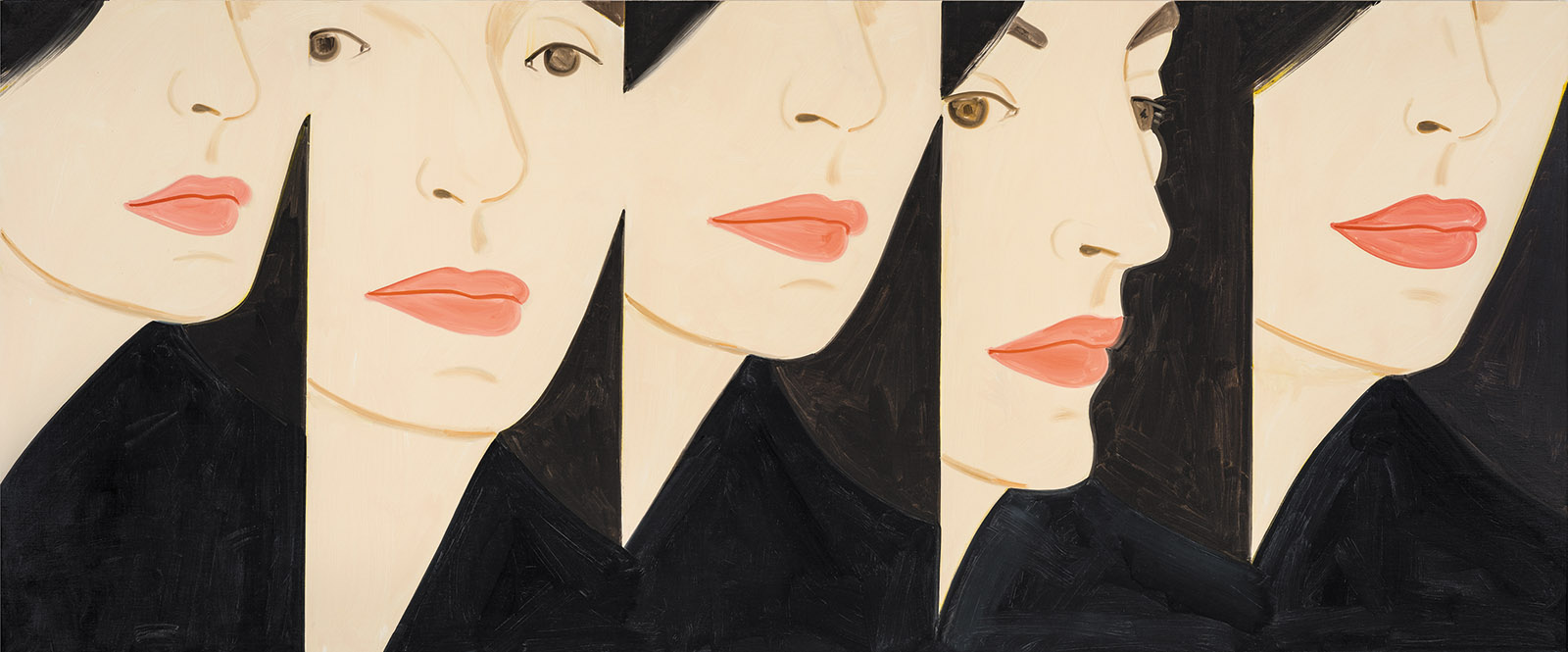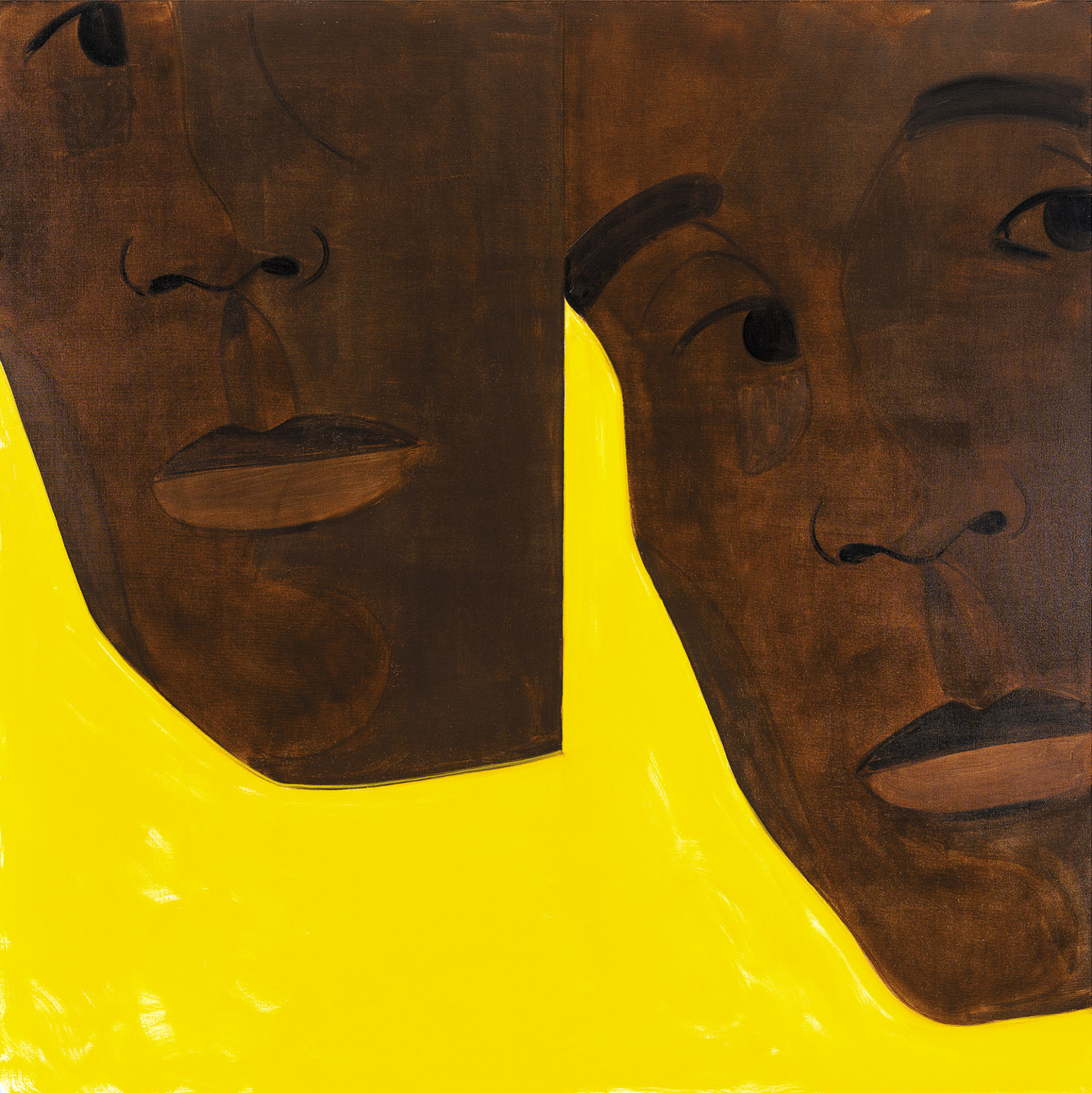Other animals use tools, but as far as I know, we’re the only ones to make paintbrushes. Painting is a physical thing, like sports or ballet. There are important exceptions, of course, like Wade Guyton and his followers, who use computers, scanners, and inkjet printers to make paintings, but for anyone not placing a heavy bet on digital tech, how one grips the brush matters, as does each finely calibrated aspect in the chain of command from brain to canvas: the size and shape of the brush, the viscosity of the paint, and the pressure exerted by the shoulder-arm-hand continuum, its direction and velocity. That’s what painting is on a physical level: brush hitting canvas. It’s been going on for a long time because the way it links perception with action intersects with something elemental about humans. Painting is no more passé than drumming or, for that matter, pole-vaulting, which is not to say that we all need to do it, or can.
Every painter is different. The way some approach the job can be compared to how a ballet dancer thinks about choreography. The steps are prescribed, and the music provides the tempo, but certain dancers have a distinctive élan or vitality that, when combined with the quality known as “attack”—the initiation of movement as well as the accents within a phrase—conveys a forthright, efficient character. Balanchine often likened choreography to carpentry, a task executed with diligence and precision. The point where technique meets an internal drive or intention represents, on the ballet stage, personality in motion.
Alex Katz paints real people, as he sees them. Starting out in the Abstract Expressionist milieu of the early 1950s, he found that his talent was best suited to realism, and if he ever looked backward, you wouldn’t know it. You can feel, in his early paintings, the struggle to translate observed reality into painted forms and still be part of the dominant conversation of the day. There was a big jump in the development of Katz’s style from the late 1950s to the early 1960s, as if, when the decade changed, someone fired a starting pistol and the race began in earnest.
One of Katz’s primary innovations was to bring the look and scale of billboards, movies, and TV to realist painting. He first deployed his invention—the head tightly cropped just above the eyes or just below the mouth, isolated on one side of the canvas—in the early 1960s with portraits of friends like Paul Taylor and Elaine de Kooning. The close-up, the fragment, the detail, along with flat color—these are some of the things that cinema gave to painting. Katz and the Pop artists, especially Roy Lichtenstein, shared a similar starting point, but the differences are instructive. Simply put, Lichtenstein made paintings of pictures, not of things, and in his hands, an image is more purely graphic; the forms coalesce by virtue of the black outline, and whatever illusion of volume we see is clearly meant to be ironic.
Katz, on the other hand, eschews outlines altogether; his precise tones map the interlocking play of light and shadow as it defines form. The overall contour of an image—the shape of the head, for example—is important, of course, and Katz is a master at the kind of extended line or brush mark that describes a form’s perimeter. But it is the interplay of the interior shapes—the areas of darks and lights that he locates within the formal schema—that contains, in his hands, the elements of drama: anticipation, conflict, resolution.
This, more than anything else, is what gives a Katz painting its air of sophistication. The way he orchestrates these shapes within a complex form, the way he shapes the shapes, is like getting dressed in a fitted black suit—you first put in the pocket handkerchief and then take it out as you realize, looking in the mirror, that it spoils the effect of the whole. In lieu of outlines, what matters are edges—the places where the shape of one color or tone touches an adjacent one of a different tone. It’s been the basis of realist painting for hundreds of years; Katz makes it modern by all but eliminating the transitions between light and dark shapes. This is styling in action: why use dozens of interior shapes to describe all the stuff that happens on a face, when just four or five will do?
“Styling” is the most frequently invoked term in the Katzian lexicon. Its precise definition is a little slippery; it can mean anything from how a work looks—its surface appearance—to the energy behind it and the mind-set from which it results. Styling, for Katz, is the sum total of the decisions, both conscious and otherwise, that place one in a relationship to the past and to what’s possible now. He can look at a painting that appears to be cutting-edge and say of it simply, “The styling is eight years out of date.” Or ten, or five, or fifty.
Advertisement
Sometimes these discussions of who is or is not on the outermost edge of the style curve can get a little abstract. One evening in the 1980s, the dancer and choreographer Karole Armitage and I were having dinner with Alex and Ada Katz in the East Village. I could see Karole starting to lose the thread at one point, as Alex was speaking. She turned to Ada and asked if, after what was already at that point quite a long marriage, she always knew what Alex was talking about. “Usually,” said Ada.
Katz has always been a great reader of poetry. In the burnished years of the late 1950s and early 1960s, the poet and MoMA curator Frank O’Hara was both a friend and a perceptive early champion of his work. In a 1966 essay, O’Hara wrote that Katz’s “‘breakthrough’…was toward enlargement of image, a move away from the personal characteristics in the handling of paint, in order to emphasize the abstractness of the subject and the inherent values it possessed, and which he released.”
Today a painting by Alex Katz is one of the most recognizable in contemporary art. His portraits are both closely observed and highly distilled—if you know them, his sitters are recognizable, but the objectivity can be a little bit frosty. The chilliness inside the intimacy is the result of two ideas, the classicist and the anecdotal, working in tandem. When asked to name the artists he most admires, Katz started his list with Jackson Pollock and ended it with “the guy who made Nefertiti.” Both are classicizing artists for whom technique is in the service of an idealized image. (It’s perhaps less obvious in Pollock, but what he gives us is an image of abstraction.) A Katz portrait, with its smooth surface and refined forms, merges that tradition with a casual, anecdotal approach that foregrounds its own workmanlike materiality. It’s classicism for Beats, or high temple art for people who live in lofts.
Katz celebrated his ninetieth birthday this past July up at his place in Maine with family and a few friends. I couldn’t be there, but I heard he took part of the day off. Gavin Brown, his New York dealer, marked the occasion by installing a group of recent paintings at the gallery’s new home on West 127th Street. Gavin Brown’s enterprise is now spread out over an entire building, the top two floors of which have impressively high ceilings, the result of removing every other floor. The main galleries are long rectangles of rough brick covered in some sections with sheetrock painted a lovely shade of gray. The rooms are almost as tall as they are wide, their proportions somewhat reminiscent of the Sistine Chapel—not bad as a backdrop for full-on chromatic painting.
The show contains landscapes, nudes, and portraits, in a variety of formats, but the big news is a group of eight-foot-square paintings of closely cropped faces isolated on grounds of strong cadmium yellow. In some paintings the square is divided vertically into halves or thirds, with different views of the same face compressed into each rectangular sliver, like adjacent frames of a comic strip or frames of a film taken seconds apart. Sometimes a head will overlap itself, like a stutter; other times a face will be cropped as if by an occluding frame, but without the additional head adjacent—just more yellow space.
These colored areas are not really backgrounds; the negative spaces, or nonfigurative parts of the painting, are painted in the same way as the heads, the paint laid down and brushed out just so, without being precious about it. The paint is purposeful and the surfaces look fresh and taut. The space pulses with the energetic wavelengths of the yellow pigment; the citron color pushes against the efficiently delineated contours of cheek, eye socket, and chin. The compressed spatial architecture of the face maintains an equilibrium, a stilled traction within the rectangle.
One painting from the show, Bill 3 (2017), will serve as an example. The eight-foot-square canvas is divided in half vertically; on either side are close-up segments of a man’s face with a beautiful skin tone somewhere between umber and sienna, the right side of the face and chiseled jaw line offset by cadmium yellow. There is very little tonal contrast within the two truncated views of this man Bill; even the whites of his eyes, as well as the lighter underlip, are brown, though of a slightly lighter tone than the rest of the face. Bill’s eyes are looking over his left shoulder, that is, to our right, and slightly down, and the head on the left, cropped even tighter, eliminates one eye altogether—a fragment of a fragment. The overall impression is of a head hacked from soft stone, rough-hewn, umber-toned, with a certain heft and mass. But the rigidity is contradicted by the softness of the brushwork at the internal edges—upper lip, side of nose, eye socket—where the brown meets a slightly darker one, and even at the face’s contours, where brown meets yellow.
Advertisement
The painting commits to a radical, stripped-down composition. If you could turn it upside down, with the two rocky cliff-like shapes of softly brushed umber checked by a yellow of almost fearful intensity, you might have an Ellsworth Kelly, but with more sophisticated color. It’s as if a newly discovered chunk of Mount Rushmore were found to also contain an homage to our friend Bill, but he’s only visible when the sky turns deep yellow, making those other guys disappear. Any way you turn it, the painting is simple, clear, bold, and internally consistent. At the same time, the close-valued colors and their specific harmonies are mysterious and evocative. The painting is glamorous and tight, a sweet/sour conundrum.
Gavin Brown helpfully reprinted the O’Hara essay in the show’s catalog. Elaborating further on the equivalence between figuration and abstraction in Katz’s work, O’Hara writes:
The isolation of a visage…in a richly colored space…reminds one of [Barnett] Newman, whose stripes do not exist in an anonymous space because the character of that space, its color, dimensions and texture, equal the slender hieratic signal of the total work’s intelligibility.
Fifty years later, comparing a painting by Katz to one of Newman’s “zip” paintings is still a radical idea, and very much to the point. A painting is everything that exists on its surface, and all of it matters. O’Hara, with his own clarity, his own brand of anecdotal classicism, then offered this summation: “Katz is a cool painter.” Cool, and also hot. A lifetime of decisiveness and will has gone into making him so.
This Issue
January 18, 2018
Damage Bigly
Divine Lust
This Land Is Our Land





